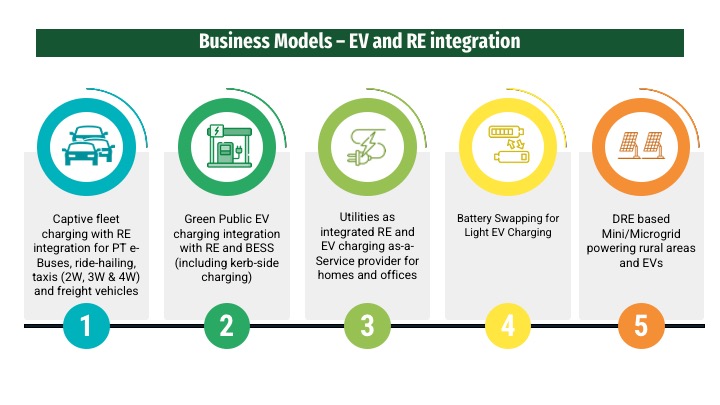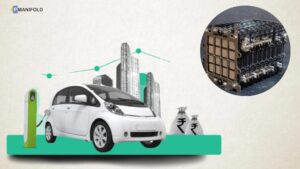
Transport and energy are important for economic growth and social development, but also major emitters of greenhouse gases. Transport emits 23% of energy-related CO2 and power industry emits 40%[1]. Hence, decarbonizing these sectors is necessary to limit global warming. Both sectors’ growth can lead to increased fossil fuel dependence and emissions. Making low-carbon energy and transport a priority for sustainable development can mitigate emissions and prevent investment in fossil fuel technologies that may become unviable before their end of life. Renewables, especially solar, wind, hydro and geothermal will play a major role in decarbonizing the power industry. Electrification of transport is a key strategy for reducing transport’s CO2 emissions.
E-mobility impact on electricity supply
The ability to electrify road transport is determined by the power sector’s capacity to provide reliable electricity, and this, at affordable cost. Beyond the need for additional capacity and grid extension, the two typical challenges of the electricity sector are high losses in transmission and distribution, and grid liability. Transmission and distribution losses are estimated to be roughly 10% (or more in many countries); they often result in either higher consumer prices or higher public expenses to cover utilities’ forgone revenue. Grid reliability is another critical factor and may pose a challenge if many EVs are being charged at the same time.
EV charging loads are anticipated to be very dynamic, with spikes in the demand curve. This can have a serious impact on the distribution network, especially in distribution areas with low available hosting capacity leading to voltage instability, harmonic distortion, power losses and unreliable supply. The impact on the grid can be minimized by introducing discounted tariffs for charging during non-peak hours like Time of Use (ToU) or Time of Day (ToD). Additionally, other EV charging management solutions like battery energy storage system (BESS), smart charging and vehicle-grid integration (VGI) can be used to mitigate the negative impacts of uncontrolled EV charging.
Trends in Renewable Energy and synergies with e-Mobility
In the past decade, renewable energy production per capita has doubled. Bhutan, which is standing out with the highest electricity production per capita in the world (3,026W), sells one hundred percent of their hydropower to neighbouring nations. China, the most populous nation on earth, is the leader in renewable energy. Its RE capacity per capita is 621W, which is 2.5 times the global average. China has six times the RE capacity per capita as India. In Sub-Saharan Africa,’s RE capacity per capita is at 38W.
Increasing renewables’ integration to the grid comes with challenges for the system’s stability such as boosting grid voltage (hampering performance of the connected power equipment like DTs by overloading), injecting harmonics etc. As a result of the intermittent nature of wind and solar generation, capital expenditure in equipment like inverters and storage is needed to reduce peak load, enhance power quality, and store excess power. Integrating storage with RE will increase implementation costs, which could impede the widespread deployment of RE. Employing RE for EV charging further requires additional grid infrastructure leading to increase in grid upgradation costs.
Conversely, integrating a greater proportion of RE sources to the grid for EV charging results in benefits like higher contribution to CO2 emission reductions; it can also help minimize grid impact challenges. RE with BESS can act as an ancillary support to the grid by storing energy during high RE output hours and supplying power during off-peak hours, enhancing system reliability and resiliency. It also provides reactive power that helps with voltage control thereby improving grid stability and minimize AT&C (aggregate technical and commercial) losses. When using V2X technology, batteries from EVs can act as BESS, supporting RE by storing power and reduce additional storage investments.
Opportunities for growing e-Mobility and RE in synergy
This section outlines opportunities at the intersection of both technologies, and presents various EV charging business models integrating RE. The business models (as shown below), look into different energy models, charging models, vehicle segments and applications.

| Business Model 1Captive fleet charging with RE integration for PT e-Buses, ride-hailing, taxis (2W, 3W & 4W) and freight vehicles | |
| Growth rationale | · Globally, there is an increasing shift to public transport (PT) bus systems, to drive operational and financial efficiency and increase fleet size with transition to e-Buses. Also, the ride-hailing freight services market is growing globally and making an economic case for their electrification.· PT e-buses, ride hailing taxis and freight vehicles having access to a dedicated depot in strategic city locations with ample spaces provide easy charging with RE integration opportunity· As the push to freight electrification grows, warehouses make most sense for charging, considering typical logistics profile of hub-and-spoke model or point-to-point, etc. and vehicle’s layover of ~5-6 hours during loading and unloading· Charging fleets with large battery capacities (for buses, trucks) demands more energy which makes a case for integrating with RE to help reduce load on the grid· Big roof tops as well as ground space in depots and warehouses provide opportunities for RE integration for charging. However, given size of fleet and required high MW level charging load (specially in case of e-Buses), captive RE alone may not be sufficient. And there will be a need for remote RE open access or trade offset. |
| Benefits | · Support peak shaving (reducing load on the grid during peak hours) using RE with BESS for charging thereby reducing grid investment cost required to manage peak demand·Reduce impact on the grid by reducing harmonics and voltage instability and thereby reduce losses in the system· e-Bus/e-Truck batteries provide good stationary RE power backup storage (as BESS) at lower cost given higher daily distance run and battery utilization thereby undergoing faster replacement |
| Limitations | · High investment cost when using batteries to store RE to power fleet overnight· Scheduling fleet to match charging pattern and RE generation requires suitable locations to install RE on site, alternatively remote access to the grid |
| Business Model 2Green Public EV charging integration with RE and BESS (including kerb-side charging) | |
| Growth rationale | · Public Charging stations (PCS) gives visibility and confidence to EV users and help curb range anxiety· More and more PCS are getting integrated in existing matured commercial locations like fuel stations (intracity and highways), malls, restaurants, parking etc. These locations typically have real-estate for RE integration.· With many users doing planned home or office charging, more and more PCS use cases including kerb-side charging are moving towards quick opportunity or top-up charging.· Real-estate space at PCS and prevailing high electricity commercial tariffs makes a business case for RE integration. Depending on space availability at the site, 100% RE can be supported with a mix of captive, remote generation wheeled through green open access, and/or RE tradable certificates.· RE plus BESS combined with a grid makes PCS greener. It also reduces both its energy and demand charges. This further integrated with smart chargers will allow PCS operators to align pricing signals with utility given ToU/ToD tariffs and drive EV charging user’s behavioural change.· BESS using repurposed batteries from EVs could further make its deployment with RE more economical |
| Benefits | · Provides better grid stability and reliability by supporting peak load shaving (reducing load on the grid during peak hours) thereby reducing the required grid investments (in equipment like inverters)· BESS at PCS will provide the necessary back-up power system at the time of grid failure/ outages and act as an ancillary support to the grid |
| Limitations | · Requires considerable land/ space for deployment (which is a constraint in urban areas)· Need for smart charging solutions to better manage multiple EV charging which also calls for high investments· Low utilization of PCS affects the business economics |
| Business Model 3Utilities as integrated RE and EV charging as-a-Service provider for homes and offices | |
| Growth rationale | · Both RE and EV economics to end-users are becoming attractive for end-users and their fast proliferation is causing high grid impact. Progressive utilities have hence started facilitating their customers to improve energy efficiency, behavioural or automated demand response (through use of ToU or ToD charging) and solar roof top generation.· In many countries, there is a growing trend of providing solar roof top (SRT) as-a-service (long term PPA) to residential and commercial customers as a RESCO model. Private utilities are playing increasing roles in extending this service to their customers.· Many utilities in the developed countries are extending the charging-as-a-service (CaaS) model to home and office customers, where they are extending investment and/or rebates and hence optimising national cost on public charging infrastructure.· EV charging shifts during high RE output hours for relatively low power e-2Ws and e-cars at home and offices through appropriate ToU and smart charging can optimise further end-user economics and also utility costs for grid expansion.· Low and middle income countries tend to have a high share of inverter and battery power backup systems at homes and offices. These storage assets can be leveraged to charge from captive SRT and then support EV charging later in the day or night. Increasing new power backup systems allowing such high loads (ACs, EVs) running through RE. |
| Benefits | · Managed and controlled charging can reduce the impact of EV charging on the grid |
| Limitations | · High investment for utilities to deploy smart technological solutions to monitor real-time integration of RE and EVs |
| Business Model 4Battery Swapping for Light EV Charging | |
| Growth rationale | · Battery swapping allows the end-user to run EV with a swap battery· Battery swapping charging station is isolated for only swap batteries charging. This allows RE integration including captive at the fuel stations forming key locations to host battery swapping. |
| Benefits | · Attractive for vehicle operators as swapping does not require time, as charging does· In commercial fleets, it increases fleet utilization, improves logistics delivery timelines, and saves time· Allows separation of batteries and EVs ownership, thereby reducing upfront cost of EVs for the end-user· Provides high asset class business model for new energy operators through improved battery life, grid responsive charging and RE integration· Reduces investments in charging network and centralizes electricity consumption· Allows using batteries as a storage (in a managed manner) and to put power back into the grid· Addresses space constraints in urban areas as multiple batteries can be stack, using less space than parking for charging |
| Limitations | · High investment cost, high automation, and high inventory of charged batteries· Battery swapping stations demands high energy from the grid to keep the batteries charged round the clock· Need for standardization of batteries (with different technologies) for interoperability without hampering technology upgradation |
| Business Model 5DRE based Mini/Microgrid powering rural areas and EVs | |
| Growth rationale | · Distributed Renewable Energy (DRE) based Mini/ Micro grids are a solution for supplying 24×7 electricity to many communities without adequate grid service· Financial viability of most mini/ micro grids requires strategies to increase electricity sales· Mini/micro grid need demand loads that can be time-shifted to periods when RE is available else to balance the demand-supply necessitates substantial storage facility· EV having a large on-board energy storage can provide base load to DRE mini/ micro-grids and potentially help mini/micro grid operators improve their economics and expand energy services· DRE based mini/ micro grid can potentially be an EV charging station like a battery swapping station that charges batteries during RE generation and then lease out these batteries to the EV drivers during operations allowing drivers to top up their EVs· DRE based mini/ micro grids can use sources like solar and biogas or even hybrid source of energy (like grid + DRE) |
| Benefits | · Provide access to affordable and reliable electricity and transport in underserved areas· Reduce loss and wastage of farm produce with increased access to transport· Provide base load to the mini grid improving economics for the operator and low-cost to the end-user· Encourage rural entrepreneurship by powering productive use applications like EVs· Ensure safety by providing power during night using battery storage· Support education by providing access to affordable transportation to schools/ colleges· Ensure seamless delivery of essential services such as healthcare, education (online learning) and internet connectivity due pandemic like situations |
| Limitations | ·High investment cost for deploying minigrids and lack of financing support· Requires regular local maintenance support (skilling) to keep minigrid working for e-Mobility application |
(The views expressed in this blog are from a Working Group Paper authored by pManifold team members developed for SUM4All and published at COP27)
More details can be referred from the following link:



